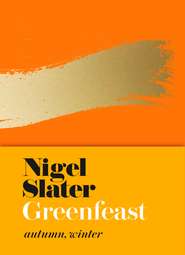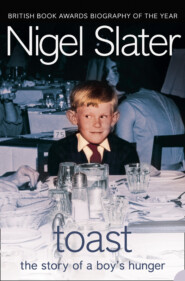По всем вопросам обращайтесь на: info@litportal.ru
(©) 2003-2024.
✖
Eat – The Little Book of Fast Food
Настройки чтения
Размер шрифта
Высота строк
Поля
Miso Soup with Beef and Kale
white miso, rump steak, cavolo nero or kale, spring onions, bouillon powder
Pull the leaves from the stalks of 100g cavolo nero or kale. Shred them, then chop the stalks finely. Pour a little oil into a shallow pan, add the chopped stems and cook briefly, then add a 240g piece of rump steak. Fry briefly and when it browns, turn over and add 3 chopped spring onions. Brown the steak on the other side, then remove from the pan and cover it, then pour 800ml boiling water into the pan and stir. Add a tablespoon of bouillon powder and 2 tablespoons of white (shiro) miso paste, then the cavolo nero leaves. Simmer until the greens wilt. Ladle into bowls, slice the steak into thin strips and drop into the broth.
For 2. Light and sustaining.
A few thoughts
• Allowing the miso to boil will make it cloudy and alter its flavour but a brief simmer will do no harm.
• Cook the pieces of meat for seconds rather than minutes, to keep them supple and rare.
• Shredded savoy cabbage, purple-sprouting broccoli and any of the Chinese greens, such as bok choi, would be perfect here instead of the kale.
• Add wide or thin ribbon noodles as you wish, or even cooked rice, to make a more substantial bowl of soup.
Roasted Beetroot and Tomato Spelt
beetroot, tomatoes, pearled spelt, garlic, coriander or parsley
Drizzle 4 small beetroot with a little oil, wrap them in foil and place in a roasting tin. Bake at 200°C/Gas 6 for 20 minutes. Open the foil, add 5 garlic cloves, left whole, and 4 largeish tomatoes and cook for another 30 minutes, until the beetroot and garlic are tender. Peel the garlic, then peel and halve the beetroot.
Boil 200g pearled spelt in 400ml salted water for 20 minutes, then drain. Melt a large knob of butter in a frying pan, add the cooked spelt and leave to toast lightly for a minute or two. Add the roast beetroot, garlic, tomatoes and some black pepper, stirring them in gently till the tomatoes burst. Stir in a handful of torn coriander or parsley.
For 2. Frugal, sweet and sharp, with the comfort of warm spelt.
Pea and Watercress Soup, Prawn Soldiers
peas, watercress, prawns, baguette, vegetable stock, shallots, soft butter, mace
Peel 2 medium shallots and chop them quite finely, then let them cook in a little oil over a moderate heat, till they are soft and translucent. Tip in 500g (podded weight) fresh peas then 1 litre vegetable stock. Stir and leave to simmer for 5 minutes.
Put most of the peas and the liquid into a food processor or blender and blitz till smooth. Add a bunch of watercress and continue processing till smooth, then return to the rest of the soup. Making it this way will give you a lightly-textured soup, more interesting than a totally smooth one. Check the seasoning.
For the prawn soldiers, roughly chop 150g shelled prawns. Cube 50g butter and mash the chopped prawns into it. Season with black pepper and a pinch of ground mace.
Thinly slice a small baguette. Spread the prawn butter on to the bread and bake for 10 minutes at 200ºC/Gas 6, or cook under an overhead grill if you prefer. Serve with the hot soup.
For 4. Sweet pea soup, crisp prawn toasts.
(#ulink_21dec86f-1f7f-5928-9e34-d657e4069875)
You melt a slice of butter in a wide, shallow pan. When bubbles appear around the edge, you slip in a fillet of fish and slowly let it cook, spooning the warm butter over and over. You watch the flesh change from pearl white to snow white and see the edges turn pale gold. You toss a salad or steam some green beans. You open a bottle of wine. You lift the fish on to a warm plate, add a little lemon juice and some chopped parsley to the butter in the pan and let it foam before pouring it over the fish. Dinner is served.
A frying pan was the first piece of kitchen kit I owned. A basic, shallow pan that saw many a meal, from a simple bacon sandwich to a full English. It helped me master everything from fish fingers to fried sea bass. I made risotto and fishcakes in it. Pork chops and hamburgers. Fried chicken and potatoes. I made curry in it, for heaven’s sake. If we have only one pan, then it should probably be a frying pan.
Cooking in a shallow, long-handled pan is spirited, high-temperature cooking. A quick fix. We need to learn to control the heat. But first we must know our pan. A thin, cheap pan isn’t ideal – the food burns too easily – but sometimes that is what we have. So we should get to know how the pan works, its hot spots and burning points, where food sticks on it and how long it takes to heat up. This isn’t just ‘chuck it in and hope for the best’ cooking. This is quick-fire food, but it needs the right pan, the right heat and the right ingredients.
I have two frying pans now, one cast iron and so heavy I need both hands to lift it, the other non-stick and light as a feather. The cast iron one is so well used it has developed its own non-stick patina, and is what I use to fry potatoes, pieces of chicken, meatballs, burgers and rashers of bacon. It is great for homemade burgers that need slow cooking. The lighter pan is for fish, rösti, frittata and flash-fried lamb’s liver. Its slippery surface makes it ideal for an omelette.
If you make them regularly, it might be worth investing in a small omelette pan. Steel is the way to go. Never wash it – just a quick wipe with kitchen paper. A new pan will stick initially. I get round this by heating a film of oil in it and letting it cool several times, then wiping it with paper. This provides a seal that will stop your omelettes and frittata sticking to the surface.
A good, flat pan with a heavy base, whether stainless steel or cast iron, is a food friend to have in the kitchen. For the full English, of course, with its bacon and sausage, black pudding, tomatoes and egg, but for so much more. The pork steak or chop that needs to be watched as it cooks; the steak you don’t want to grill; the leftover steamed rice you are resuscitating as fried rice, and for vegetables, chicken and anything else that will cook in a few minutes. It’s the lifesaver pan. The one we all start with. The one Mum packs in our backpack when we leave home. Hopefully with a copy of this book.
A few favourites
Sole, asparagus, dill
Melt a thick slice of butter in a non-stick pan and add a little olive oil. Add 6 asparagus spears, each spear cut in half then into 3 or 4 pieces, and let them cook for a minute or two. Scatter in a few roughly torn dill fronds, then lay 2 lemon sole fillets into the pan carefully, skin-side down and side by side, and spoon the asparagus and butter over them. Season, then continue cooking for 4 or 5 minutes, regularly spooning the hot butter and asparagus over the fish until the flesh becomes opaque.
Salmon, spinach, garlic
Fry a piece of salmon in a little oil in a shallow pan, seasoning it with salt as you go. Remove the salmon to a warm place (such as a warm plate with a cover). Put a clove of garlic, peeled and very finely sliced, in the fish pan, let it colour lightly, then add a couple of handfuls of spinach, toss them around in the hot pan, then add a slice of butter and a squeeze of lemon. Serve under the fish.
A sweet, mildly spiced side dish for pretty much anything
Coarsely grate about 400g carrots. Add a crushed clove of garlic, a grated thumb-sized lump of fresh ginger and a finely chopped hot chilli. Melt a little butter in a shallow pan then tip in the carrots, toss gently as they cook, then add a handful of chopped roasted cashews, 4 tablespoons of double cream and the same of yoghurt, then scatter with chopped coriander leaves.
The sweetness of carrots, the coolness of mint
Gently scrub 450g spring carrots, removing their leaves as you go, then cook them in a little oil in a shallow pan. Keep the heat low, rolling them over now and again and letting them brown very slightly in patches. Add 2 tablespoons of chopped mint and 3 heaped tablespoons of yoghurt to the pan. A side dish really, but satisfying enough with bread and cheese or cold cuts.
Potato and mushroom rösti
Grate some potatoes coarsely, then toss them with the beaten egg and flour. Season them with chopped thyme, shape into patties and fry in hot butter till lightly crisp and golden. Drain on kitchen paper for a few minutes, then top with fried sliced mushrooms and crème fraîche.
Rösti and meat juices
Potato rösti are wonderful slipped under grilled lamb steaks or a piece of fillet steak. Something sensational about the crisp tangled straws of potato when they pick up some of the meat juices.
A mustard and tarragon sauce for steak
Put a tablespoon of Dijon mustard, the juice of a lemon and about 20 tarragon leaves in a blender or food processor with 50ml olive oil and blitz to a thick purée. Whilst the cooked steak rests, tip the juices from the pan into the tarragon sauce, blend and serve with the steak.
A red chilli and tomato sauce for steak
While your cooked steak rests, add a deseeded and very finely chopped red chilli to the pan, soften over a moderate heat then add a few chopped tomatoes, some salt and let the tomatoes cook down to a spicy red slush. Crush with a fork, stir in a handful of chopped coriander and serve with the steak.
Rice Cakes
leftover chilled risotto, egg, dried breadcrumbs, Emmental or Gruyère, lemon
Beat an egg lightly in a shallow dish. Tip a couple of handfuls of dried breadcrumbs on to a plate. Cut the Emmental or Gruyère into small dice and fold into your cold risotto. Take generously mounded serving spoons of the mixture and roll into balls or flat patties (the shape is up to you) then drop them into the beaten egg followed by the breadcrumbs.
Heat a shallow layer of oil in a frying pan and fry the cakes a few at a time, till they are crisp on all sides, turning carefully (they are fragile) as you go. Serve 2 croquettes per person with lemon halves.
Crunch and soft. Melting cheese.











